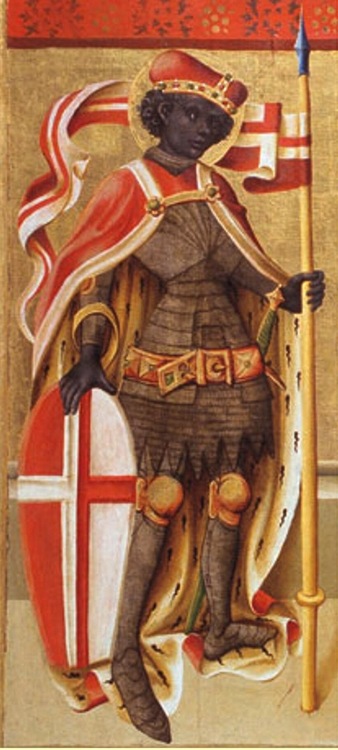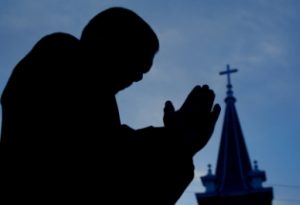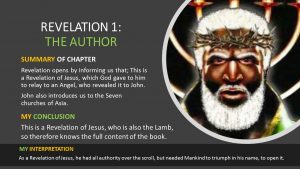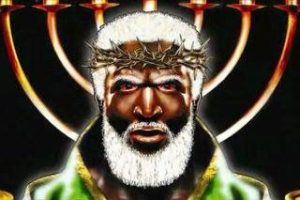The Temple Guards, what & who are they?
Why are their Temple Guards & what or who do they represent?
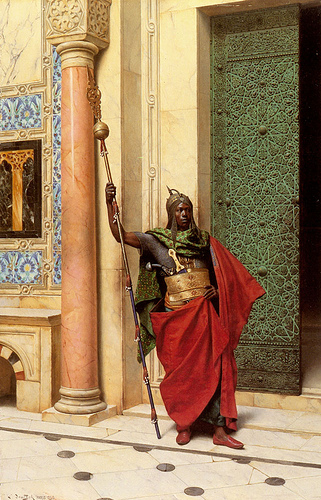 As you will see as you proceed through this website, The Temple of Yahshuah, as well as all the Living Temple’s set up through this website, are actually, spiritual but physical functional Temples, literally. Therefore this particular Temple and we advise individual Living Temples particularly those housed within people of African Ancestry, to be Guarded by these exact same guards, or a selection very similar, without alteration of the main three Guards.
As you will see as you proceed through this website, The Temple of Yahshuah, as well as all the Living Temple’s set up through this website, are actually, spiritual but physical functional Temples, literally. Therefore this particular Temple and we advise individual Living Temples particularly those housed within people of African Ancestry, to be Guarded by these exact same guards, or a selection very similar, without alteration of the main three Guards.
Now as a functioning Temple, as with the Temple of Solomon, the temples in Ancient Egypt and most temples from any other culture, a temple must have guards, as they usual house many precious and very valuable relics. These temple guards are always priests and in the case of Solomon’s Temple, physically there were many, for the purpose of this Temple however and for that of the Living Temple of people of African heritage, we use and recommend a specific number of 24 Priestly Guards. Three High Priest with different Roles, and 21 other priest all of a similar ranks, equal to, however not the same as those of the High Priests. This number of 24 Priests is symbolic and also represents and coincides directly with the 24 Elders, praying on Our Behalf before the Father, as well as to help protect the Living Temple’s over the entire 24 hours of the day.
Although symbolic, like every other aspect of this and all other Living Functional Temple, this symbology must be represented in a way and with the specific intention to help the Mind to create an mental image and picture that the individual can use practically, to help them construct their Temple on a solid foundation.
How We Selected Our Temple Guards
In regards to our chosen Guards for this Temple, we have selected 24 individuals, male and female, based on a specific and strict criteria. This criteria includes aspects and characteristics that we believe qualify’s them for this particular role, this includes people, who we believe have;
- Contributed something very significant to the heritage of Yahshuah (Jesus), particularly amongst African people,
- Lived & Died upholding and proclaiming the Gospel of Yahshuah.
- Ascended to the Most High and are praying amongst the myriads of Saints of all nationalities, but specifically on our behalf, meaning African people, saying how long how long?
A list of these 24 Temple Guards and the reasons they have been selected are listed below.
Who are the Temple Guards and why?
The first 3 Guards or Mini-Stars, featured as 1, 2 & 3, represent the Monarchy, Presidency & Patriarchy, representing the Kingdom, Government & Church, functions of the Temple respectively. They are here presented alongside the other 21 selected Mini-Stars, featured in no particular order. However it should be noted here that as individuals beings there are actually 25 persons, as the 1st Guard, presenting the Monarchy, in True African and Unversal Spirituality, it is dual, male & female, in order to ensure complete Balance (Ma’at).
1. Haile Sellassie & Menen Asfaw
The Perfect Monarchy
The Emperor and Defender of the Faith
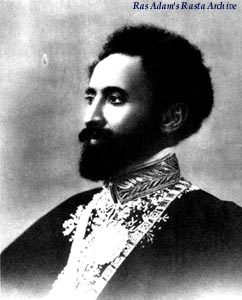 His Imperial Majesty, Emperor Haile Selassie Ist, of Ethiopia, King of Kings, Lord of Lords, Conquering Lion of the Tribe of Judah. Elect of God and Light of this world. The Defender of the Ancient Oriental Orthodox Christian Faith.
His Imperial Majesty, Emperor Haile Selassie Ist, of Ethiopia, King of Kings, Lord of Lords, Conquering Lion of the Tribe of Judah. Elect of God and Light of this world. The Defender of the Ancient Oriental Orthodox Christian Faith.
Born: 23 July 1892 and last seen on 27 August 1975. Born Lij Tafari Makonnen, was Ethiopia’s regent (Ras & Negus), from 1916 to 1930 and emperor from 1930 to 1974. He was a co-founder for the vehicle for African & Israel’s unity and regathering from exile and also served as its Chairperson, namely the Organisation of African Unity from 25 May 1963 to 17 July 1964 and 5 November 1966 to 11 September 1967.
He also fulfilled his divine role and duty to regather the most Ancient Oriental Orthodox Christian Church’s, after 1514 years of isolation, ending and fulfilling the Gentiles times, of domination over the Christian Faith, when he assembled the esteems Oriental Patriarchs, in January 1965, at the Addis Ababa Conference or Council, to spearhead, the spreading of the Gospel by the Orientals throughout the world for the first time, as well as the impetus and foundation upon which this website was built. Haile Sellassie Ist was also a member of the Solomonic Dynasty who traced his lineage to Emperor Menelik I via his Shewan Amhara royal ancestors as a great-grandson of king Sahle Selassie.
The Empress and Co-Defender of the Faith
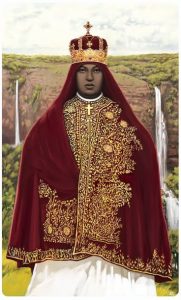 Her Imperial Majesty Empress, Menen Ist, of Ethiopia, Queen of Queens, Lady’s of Lady’s, Conquering Lioness of the Tribe of Judah. Elect of God and Light of this world. The Co-Defender of the Ancient Oriental Orthodox Christian Faith.
Her Imperial Majesty Empress, Menen Ist, of Ethiopia, Queen of Queens, Lady’s of Lady’s, Conquering Lioness of the Tribe of Judah. Elect of God and Light of this world. The Co-Defender of the Ancient Oriental Orthodox Christian Faith.
Empress Menen Asfaw (Baptismal name Walatta Giyorgis) was born on the 26 Magabit 1881 Ethiopian Calendar, 3 April 1889 Gregorian Calendar, the Empress ascended on 15 February 1962. She was the Empress consort of the Ethiopian Empire and wife of His Imperial Majesty Emperor Haile Selassie Ist and like her husband, had descended from the Ethiopian Solomonic linage. Empress Menen was active in promoting women’s issues in Ethiopia, was Patroness of the Ethiopian Red Cross, and the Ethiopian Women’s Charitable Organization. She was also patroness of the Jerusalem Society that arranged for pilgrimages to the Holy Land.
The Empress was also a devoutly religious woman who did much to support the Ethiopian Orthodox Tewahedo Church. She built, renovated and endowed numerous churches in Ethiopia and in the Holy Land.
Some of these were; the St. Raguel Church in Addis Ababa’s Merkato district; The Kidane Mehret (Our Lady Covenant of Mercy) Church on Mount Entoto, and the Holy Trinity Monastery on the banks of the River Jordan in the Holy Land. She also gave generously from her personal funds towards the building of the new Cathedral of St. Mary of Zion at Axum.
She was referred to as the “God fearing Empress” who was always praying to God
When the Empress was exiled from Ethiopia during the Italian occupation from 1936 to 1941, she made a pledge to the Virgin Mary at the actual Church of the Nativity in Bethlehem, promising to give The Holy Virgin her crown, meaning to the church, if Ethiopia were liberated from Italian, Roman Catholic occupation.
In 1941 on return from exile, a replica of the crown was made for future Empresses, but the original crown that Empress Menen was crowned with at her husband’s side in 1930, was sent to the Church of the Nativity in Bethlehem, the Empress would never again wear a full crown. Her Crown remained on open display in this Church in Jerusalem for many years thereafter and today the Empresses Crown, Pledged by Her personally to the Virgin Mary directly, remains still, in this most Holiest and Sacred of places in the entire Christian world, in the Church of Nativity, in Jerusalem, the spot it is believed that Yahshuah came into this world.
The Credentials and Significance:
HIM Haile Sallassie Ist represents and symbolises Yahovayah promise and covenant with David and is the awaited SEED of DAVID, prophesied & fulfilled. He is the Promised ENSIGN and signal prophesied to herald the regathering of Israel, both physically and spiritually, meaning the Kingdom & Church on earth, accomplished through the OAU 1963 & the Addis Abba Council 1965. HIM Haile Sallassie Ist, together with his wife Empress Menen Ist, combine to form the 1st Guard, representing the TRUE Monarchy, ordained and Sanctioned by the One God of Ethiopia. They are perfect role models for not only African Christian’s, but all humanity.
2. Marcus Garvey
The Prophet, Patriarch & Papas
The Right Honourable & Excellent Marcus Moziah Garvey.
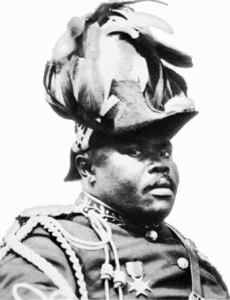 Marcus Mosiah Garvey Jr. was born on the Caribbean Island of Jamaica on the 17 August 1887 & ascended on 10 June 1940. Marcus is credited as being the most influential individual in the struggle of African people, from European or any other external domination and oppression. No other figure has contributed and influenced the minds of African people on such a grand scale, before his time or since. Garvey although from the small Island of Jamaica, has had an influence consciously amongst African people on a global scale unparalleled. He was also a proponent and one of the founders of Black nationalism in the United States and most importantly in Jamaica. He was a leader of the largest mass movement, often called Pan-Africanismm, but actually Ethiopianism (one of the founders of Pan- Africanism, W.E.B was Garvey’s main rival in the U.S). Garvey also and he founded the Universal Negro Improvement Association and African Communities League (UNIA-ACL) and Black Star Line, two of the most revered vehicles and instruments in the history of African people struggle for freedom over the past 500 years.
Marcus Mosiah Garvey Jr. was born on the Caribbean Island of Jamaica on the 17 August 1887 & ascended on 10 June 1940. Marcus is credited as being the most influential individual in the struggle of African people, from European or any other external domination and oppression. No other figure has contributed and influenced the minds of African people on such a grand scale, before his time or since. Garvey although from the small Island of Jamaica, has had an influence consciously amongst African people on a global scale unparalleled. He was also a proponent and one of the founders of Black nationalism in the United States and most importantly in Jamaica. He was a leader of the largest mass movement, often called Pan-Africanismm, but actually Ethiopianism (one of the founders of Pan- Africanism, W.E.B was Garvey’s main rival in the U.S). Garvey also and he founded the Universal Negro Improvement Association and African Communities League (UNIA-ACL) and Black Star Line, two of the most revered vehicles and instruments in the history of African people struggle for freedom over the past 500 years.
Unbeknown to most Garvey’s sole inspiration, his primary motivation and acclaimed guidance was from Yah & Yahshuah specifically. Garvey was a devote Christian and has done more than any other individual to date, to provide a African people with a totally African centred view of Christ. This information is seldom known, but is the back bone of the Yahshuah Temple website, as Garvey’s specific quotes relating to the Christ, Christianity and Yah, are featured throughout.
The Credentials and Significance:
Garvey was a messenger from the One God, Yahovayah, with a Message of the One God, specifically to awaken the spiritual 1st eye of Africans, worldwide. Calling the lost sheep, out of darkness and lead them in wilderness, in preparation to renter the Promise Land. He is the promised “Prophet Like on to Moses” Deut 18:15,18 and a Prophet like on to John the Baptist, heralding the coming of the Promised Seed, in our modern times, therefore being also a symbol of Elijah.
3. Martin Luther King Jnr
The Archbishop & Preacher
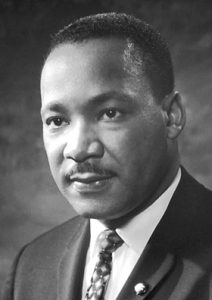 The Right Honourable Reverend Dr. Martin Luther King Jr.
The Right Honourable Reverend Dr. Martin Luther King Jr.
Rev. King was one of the greatest Christian evangelical influences of the 20th century. King was born on January 15, 1929 and ascended on April 4, 1968, after being assassinated and marted, for preaching the True Gospel.
He was an African American Baptist Christian a minister and activist who became the most visible spokesperson and leader in the civil rights movement from 1954 until his ascent in 1968. Although Rev. King is best known for advancing civil rights through nonviolence and civil disobedience.
His Christian beliefs and his african centred view of Christ, enabled him to use of the gospel as a weapon and tool to liberate African people, politically, socially and economically, exactly as the Gospel was originally intended.
The Credentials and Significance:
He bore his Cross, for Christ and suffered the same fate. He was his Brothers Keeper and was a Mini-Star and Good Shepherd who demonstrated the greatest love, as he laid down his life for the sheep and his Brethrin.
He was given a view of Mt Zion, in life, through his Own Temple and he assured us that we as a people, meaning African, will, one day get there.
4. Paul Bogle
Guardian of A Temple Gate
The Right Honourable Deacon. Paul Bogel
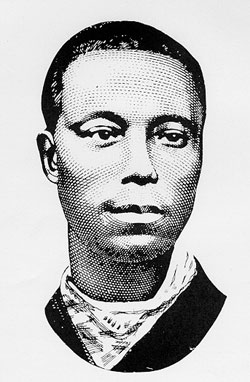 Paul Bogle was born in the Caribbean Island of Jamaica in the year 1822 and ascended on 24 October 1865, after being assassinated and martyred, by the British army, for trying to seek justice in the name of Christ, for his fellow Jamaican, newly freed from chattel, plantation slavery. Paul Bogel was a Jamaican Baptist deacon and activist.
Paul Bogle was born in the Caribbean Island of Jamaica in the year 1822 and ascended on 24 October 1865, after being assassinated and martyred, by the British army, for trying to seek justice in the name of Christ, for his fellow Jamaican, newly freed from chattel, plantation slavery. Paul Bogel was a Jamaican Baptist deacon and activist.
He is a National Hero of Jamaica. He was a leader of the 1865 Morant Bay protesters, who marched for justice and fair treatment for all the people in Jamaica. After leading the Morant Bay rebellion, Bogle was captured by government troops, tried and convicted by British authorities under martial law, and hanged on 24 October 1865 in the morant bay court house. like other African’s who came before him and those who came after.
Paul had interpreted the Gospel of Yahshuah to mean something quite different from how Jesus, with Europeanised spectacles commonly perceived. In accordance with an African-centred view of the Christ and the Gospel, Paul saw within the divine word the inspiration, authority and necessity, to use the Holy Message, to uplift his downtrodden fellow Jamaicans, out of the political, social, economical and educational turmoil and degradation that western Christian policy had determined for his people. He like his Shepherd also Bore his Cross and like a Good Servant following his Master Yahshuah, he likewise lay down his life for the sheep and his brethrin. Paul Bogel is also a National hero of Jamaica.
The Credentials and Significance:
He bore his Cross, for Christ and suffered the same fate. He was his Brothers Keeper and was a Mini-Star and Good Shepherd who demonstrated the greatest love, as he laid down his life for the sheep and his Brethrin. He was a Baptist preacher, who had been influenced specifically by the Ethiopianism Christian movement that had sent out missionary’s from the U.S, to all parts of the then Black world, to propagate this new message, including Jamaica, in 1782, through Rev, George Lisle, also selected as a Temple Guard.
5. Sam Sharpe
Guardian of A Temple Gate
The Right Honourable Deacon. Daddy Sam Sharpe
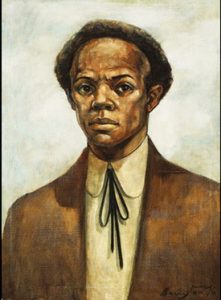 Samuel Sharpe was born in the year 1801 and ascended on 23rd May 1832), he also known as Daddy Sam Sharpe. Sharpe was an enslaved African Jamaican man who was the leader of the widespread 1832 Baptist War slave insurrection (also known as the Christmas Rebellion) in Jamaica.
Samuel Sharpe was born in the year 1801 and ascended on 23rd May 1832), he also known as Daddy Sam Sharpe. Sharpe was an enslaved African Jamaican man who was the leader of the widespread 1832 Baptist War slave insurrection (also known as the Christmas Rebellion) in Jamaica.
Sharpe became a well-known preacher and leader in the Baptist Church, he was a deacon at the Burchell Baptist Church in Montego Bay. Sharpe spent most of his time travelling across Jamaica, preaching Christianity, which he believed promised freedom.
Sharpe organised a peaceful general strike across many estates in western Jamaica to protest working conditions. However violent reprisals by the plantation owners, led to armed resistance. Sharpe’s originally peaceful protest turned into Jamaica’s largest slave insurrection and uprising, known to history as The Baptist War. The uprising lasted for only 10 days and spread throughout the entire island, mobilizing as many as 60,000 of Jamaica’s enslaved African population.
Leading up to his execution, while in jail, Sharpe had several meetings with Rev. Henry Bleby, a missionary, who reported that Sharpe told him:
“I would rather go out and die on that gallows, than live a slave”
He was proclaimed a National Hero of Jamaica in 1975.
The Credentials and Significance:
He bore his Cross, for Christ and suffered the same fate. He was his Brothers Keeper and was a Mini-Star and Good Shepherd who demonstrated the greatest love, as he laid down his life for the sheep and his Brethrin.
Like his fellow Jamaican, icon Paul Bogel, who came later, he was also a Baptist preacher, influenced specifically by the Ethiopianism Christian movement that was sweeping the Black world at the time. Samuel actually took his surname, from George Lisle, or George Sharpe as he is also known, as he was a Pastor of the same Baptist Congregation in Jamaica that George himself had founded in 1782.
6. Richard Allen
A Temple Guardian of Windows
The Right Honourable Bishop. Richard Allen
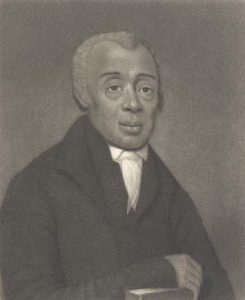
Richard Allen (February 14, 1760 – March 26, 1831) was a minister, educator, writer, and one of America’s most active and influential black leaders.
Richard was born into slavery on February 14, 1760, on the Delaware property of Benjamin Chew. He taught himself to read and write and joined the Methodists aged 17. He began evangelizing the African slaves and attracted criticism from local slave owners. By age 30, Allen had performed enough extra work to earn the money to buy his own freedom in 1780, when he changed his name from “Negro Richard” to “Richard Allen.
Allen was qualified as a preacher in 1784 , alongside, Absalom Jones, also a Methodist preacher, they together resented the white congregants’ segregation of blacks for worship and prayer. In 1787 they decided to leave the white controlled church, to create independent worship for African Americans and formed the Free African Society (FAS), a non-denominational mutual aid society that assisted fugitive slaves and new migrants to the city.
Allen focused on organizing a denomination in which free blacks could worship without racial oppression and slaves could find a measure of dignity. He worked to upgrade the social status of the black community, organizing Sabbath schools to teach literacy and promoting national organizations to develop political strategies. The social themes of Bishop Allen’s preaching were abolition, colonization, education, and temperance.
The African Methodist Episcopal Church is the oldest and largest formal institution in black America.
The Credentials and Significance:
He devoted his life to first obtaining his own freedom, then that of his brethrin, not only physically but also spiritually. He founded the African Methodist Episcopal Church (AME) in 1794, the first independent black denomination in the United States and was elected its first bishop in 1816. He saw the need for African’s to worship the Divine and Christ, through there own unique spectacles and Temples. What he founded based upon this premise, is today the most successful black institution in the United States, still today.
7. Mark the Evangelist
A Temple Guardian & Keeper of the Scrolls
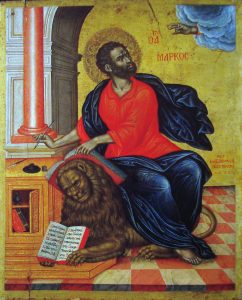
Saint Mark the Evangelist
Saint Mark the Evangelist is the traditionally ascribed author of the Gospel According to Mark, the second canonical book of the New Testament. The Gospel According to Mark, is one of four canonical gospels and one of the three synoptic gospels.
It tells of the ministry of Yahshuah from his baptism by John the Baptist to his death and burial and the discovery of the empty tomb. There is no genealogy of Yahshuah or his birth narrative, or any post-resurrection appearances.
Mark although living and possibly growing up in Israel, is thought to have been a native African, born in Cyrene, a city in the Pentapolis of North Africa (now Libya).
In AD 49, about 19 years after the Ascension of Yahshuah, Mark travelled to Alexandria and founded the Church of Alexandria – The Church Mark founded in Alexandria, became one of the most important episcopal sees of Early Christianity. Today aspects of the Coptic liturgy can be traced back to Mark himself. He became the first bishop of Alexandria and he is honoured as; the founder of Christianity in Africa. His title that has been inherited by all succeed Patriarch’s who have sat on his Seat or Throne, ever since, is;
Papias (Pope) of Alexandria and Patriarch of all Africa,
with succeeding Patriarchs adding;
On the Holy See of St. Mark the Apostle.
St Mark’s house in Judea is thought also to have been the location of the 1st church, in Jerusalem, the actual place where the Holy Spirit came down upon the Apostles at Pentecost. It was also possibly the place where the Last Supper took place also. St Mark in 62AD baptised Anianos, the 1st Egyptian Bishop & 2nd Patriarch of Alexandria and All Africa, his symbol is the winged lion.
The Credentials and Significance:
St Mark’s iconography usually depicts him, in a wilderness, often by a large river, holding a scroll in his hand and seated alongside a lion. This symbol represents the True African-Ethiopian/Egyptian & Israelites/Christians who will find themselves in the wilderness (darkness), but will be saved by the Holy Word (The Bible) that will be overstood, after being fulfilled by the signal the coming of Davidic King (Lion).
8. St Simon Cyrene
A Temple Guardian & Elder
The Bearer of the Cross of Victory
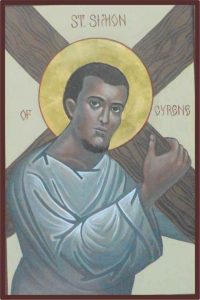
Simon of Cyrene /saɪˈriːni/ (Hebrew: שמעון “Hearkening; listening”, Standard Hebrew Šimʿon, was the man compelled to carry the actual cross of Yahshuah as He was taken to his crucifixion, according to all three Synoptic Gospels.
“And as they came out, they found a man of Cyrene, Simon by name: him they compelled to bear his cross.”
The Gospel According to Mark also identifies Simon as “the father of Alexander and Rufus”. Mark 15:21, who became Christian missionaries.
Mark at verse 8:34 refers to Yahshuah as saying to the multitude and his disciples:
“Whoever wants to come after me, let him deny himself, and take up his cross, and follow me.”
Significantly, this is in the context of a conversation with Simon Peter, who later goes on to deny Yahshuah. So since Simon Peter fails to take up his cross, Simon of Cyrene does so instead.
With this is mind, we draw our attention to the words of The Rt. Hon. Marcus M. Garvey, when he explain’s the true significance of the act specifically to African Black people, when he states;
“Man was redeemed by Christ
to reach the perfect state as man, through his soul.
The symbol of the Christ was the Cross in sentiment,
therefore, man adores the Cross.
The Black man has a greater claim to the Cross than all other men.
If it is a symbol of Christ’s triumph,
then the African should share in the triumph because
Simon the Cyrenian bore the Cross.
Simon the Cyrenian shared in the original triumph”.
The Credentials and Significance:
He denied himself, took up and carried the Actual Cross of Yahshuah and thereafter followed him. He only of all men or women carried the actual cross 0f the Karast, a blessing unsurpassed, before his time or since in the history of the world. As we see from the above quote, he bore this Cross, on behalf of fallen humanity, sharing some of the burden of the flesh, through Yahshuah Victory on the Cross, Simon also became Victor as did and will everyone who follows. He is the standard and the symbol of all African Christians,
9. St Ananius
A Temple Guardian of Windows
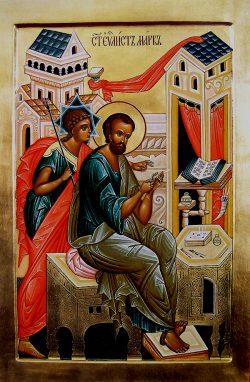
St Ananius the Bridge between the Old & New Faith
Papais (Pope) Anianus, was second Papais of Alexandria and All Africa & Patriarch of the See of St. Mark.
He was ordained as the successor of Saint Mark the Evangelist in 69D, and was also the first convert Mark won to Christianity in Africa.
The story relating the conversion of Anainus to Christianity, by St Mark in 42 AD, just a few years after Yahshuah’s Ascension, offer’s us a remarkable insight into the true heritage of the religion and spirituality of African’s and Egypt in particular, seldom understood or promoted through the mainstream.
The story goes as follows:
As Mark was entering Rakotis, a suburb of Alexandria, after his trip from Cyrene to thePentapolis, the strap of his sandal fell off.
He found a cobbler, Anianus, to repair it. While he was working on the sandal, the awl slipped in Anianus’ hand, piercing it. Anianus cried “Heis ho Theos” (“God is one”) in response to the pain. Mark took the opportunity of Anianus’ scream to preach the Gospel of Christianity to him, at the same time reportedly miraculously healing Anianus of his wound.
After Mark had preached the Gospel to Anianus, he was invited to Anianus’ house, where he taught Anianus’ family the Gospel and baptized them all. Anianus soon turned his house into a church, and it is said that it is the one known as the church of St. Mark which stands today in Alexandria. Following the martyrdom of Mark on the 30th day of Baramudah after he had returned to Alexander, after travelling the Mediterranean for 2 years, Anianus became the patriarch of the church in Alexandria. The number of Christians in the area grew significantly, and Anianus ordained new priests and deacons for the growing church.
The Credentials and Significance:
He was the 1st person Baptised in Egypt, into the new Faith. However, interestingly and significantly, Anianus before having the Gospel preached to him by St. Mark, although being a so called pagan Egyptian, already knew, worshipped and followed the 1st commandment and the foundation upon which all African Spirituality is built, notwithstanding this particular Temple website, i.e. That God or Yahovayah is One. This is very important a relevant for all African Christian’s and none Christian’s, to understand this fundamental principle that from time immemorial and across the entire spectrum of African Spirituality, God is One.
10. Kimpa Vita
Guardian of A Temple Gate
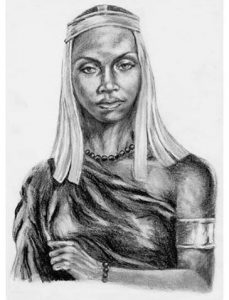
Dona Beatriz Kimpa Vita was born in the year 1684 and ascended on the 2nd July 1706.
Kimpa Vita as she is best known, was a Kongo Empire prophetess and the leader of her own Christian movement, Antonianism. Her movement taught that Yahshuah (Jesus) and other early Christian figures were African and came from the Kongo Empire, she also reproach the white Catholic priests in the Kongo, for not believing as she did.
Kimpa Vita was born near Mount Kibangu in the Kingdom of Kongo, now a part of modern Angola around 1684. She was born into a family of the Kongo nobility.
Her doctrine and message had grown out of the traditions of the Roman Catholic Church in the Kongo. Dona Beatriz had had a vision and as a consequence believed that she was a reincarnation of St. Anthony and tasked to restore the Great Kingdom of Kongo, as a unified Christian Kingdom.
She was ordered to build a specific Congolese Catholicism and unite the Congo under one king. She destroyed “idols”, the various Kongo Nkisi or charms inhabited by spiritual entities, as well as Christian paraphernalia.
Kimpa Vita is seen as an antislavery figure and is known as a prefigure to all modern African democracy movements. Three months after her vision of Saint Anthony, Kimpa Vita led her followers to the abandoned capital of Sao Salvador (Old Kongo Empire), where they would call to the people in the countryside and rapidly repopulate the city. Due to this rapid success, Kimpa Vita, soon became a major threat to the authorities, who accused of heresy, she was soon captured convicted of heresy and burned at the stake in July 1706.
The Credentials and Significance:
Her legacy continued after her martyrdom, as throughout eighteenth century Kongo religious art mostly featured Yahshuah as an African, and that Saint Anthony, known as “Toni Malau” was still very prominent. More recently, the expanding present day Kimbanguism is seen as a direct successor of her movement. Dona Beatriz offers us another example throughout the history of Christianity in Africa, where the Christ, has been seen directly through the Spectacles of Ethiopia.
11. Simeon Kimbangu
A Temple Guardian of Windows
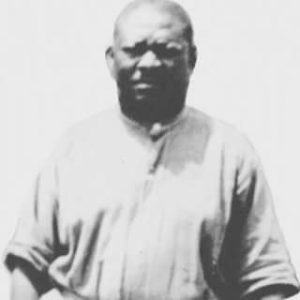
Envoy of Yahshuah to Africa and the Kongo
Simeon Kimbangu was born on 12 September 1887 in the Congo, Central Africa and ascended on the 12th October 1951. Kimbangu was a Congolese religious leader and the founder of Kimbanguism, one of the largest independent Christian movements in Black Africa. His followers consider him to be the special envoy of Jesus Christ.
Kimbangu became a Baptist in 1915, and worked as a catechist for several years before beginning his own ministry in early 1921. He began his preaching and ministry in the early part of the year 1921, around the month of April. He immediately began to cure the sick of all types of ailments, diseases and life-long disabilities; he also even raised the dead back to life, in the name of Yahshuah, according to his followers. Due to his success, through the power of the Holy Spirit that guided and moved within him, his ministry developed rapidly and scores of Congolese people began to flock to him and follow him. This caused suspicion and was seen as a major threat to the Belgian authorities.
Both the Protestant and the Catholic religious establishments in the Congo became alarmed and appealed to the colonial authorities who sought his arrest. Simeon Kimbangu alongside some of his followers was soon arrested on 6 June 1921, but Kimbangu escaped. His ministry continued in hiding for a few months, but in September he turned himself in to the authorities.
He was immediately put before a military court, without legal representation, found guilty of undermining public security and disturbing the peace, was sentenced first to death, but this was commuted by the King of Belgium to life imprisonment. He spent the rest of his life in Elisabethville prison, where 30 years later he ascended, on 12 October 1951.
The Credentials and Significance:
His ministry of preaching and miraculous healing which had lasted only from April to September 1921 a total of around six months before his life imprisonment, is proof that the Holy Spirit was with him. He achieved the standard determined by the Good Shepherd, to be called by His Name, a Christian or Karastian more precisely. He was A Great African Christian, who was totally none-violent and preached only peace and love through Yahshuah.
12. Nat Turner
Guardian of A Temple Gate
The Right Honourable Deacon. Nat Turner
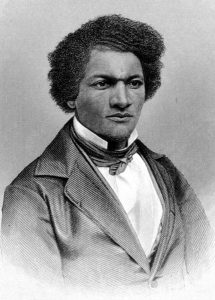
Nat Turner was born October 2, 1800 and ascended on November 11, 1831. Turner was born and lived in Southampton County his entire life. This county was a plantation area where slaves made up the majority of the population.
At a very early age, it was evident that Nat, as he was affectionately known, had a natural intelligence surpassed by few others in his circumstance. He learned to read and write at a young age and became deeply religious. Nat was a very zealous and devote Karastian (Christian) and was often seen fasting, praying, or immersed in reading the stories of the Bible. His religious convictions manifested as visions, which he interpreted as messages from Yahovayah (God). Nat often conducted services, preaching the Bible to his fellow slaves, who referred to him as “The Prophet”.
In early 1828, one of Nat’s visions convinced that he “was ordained for some great purpose in the hands of the Almighty.”
While working in his owner’s fields on May 12, Turner said later that he;
“Heard a loud noise in the heavens, and the Spirit instantly appeared to me and said
the Serpent was loosened, and Christ had laid down the yoke he had borne for the sins of men,
and that I should take it on and fight against the Serpent, for the time was fast approaching
when the first should be last and the last should be first”.
Nat’s vision also saw him as participant in the confrontation between God’s Kingdom and the anti-Kingdom that characterized his social-historical context, i.e physical & spiritual Slavery vs Freedom. Nat had believed that revolutionary violence would serve to awaken the attitudes of whites to the reality of the inherent brutality, ungodly and anti-christ-like, was the system of chattel slavery.
On August 7th 1831 there was a solar eclipse, Nat interpreted this as a final signal, and about a week later, on August 21, he began his uprising and insurrection. The uprising was suppressed within two days, Nat however wasn’t captured until October 30. On November 5, 1831, Turner was tried for “conspiring to rebel and making insurrection”, convicted, and sentenced to death. He was latter hanged on November 11 in Jerusalem, Virginia. His body was flayed and beheaded as an example to frighten other would-be Christian revolutionary’s.
The Credentials and Significance:
Although only lasting two days, this insurrections is one of the only recorded successful revolts or attempted insurrections in African American history. It therefore symbolises the total African American resistance. This is further proof that Gospel when seen through Ethiopian Spectacles, does not and cannot equate to being passive, submissive and inactive, but to the contrary forces you to action, gives you confidence so that in your faith, you leave a legacy for generations that follow.
13. Harriet Tubman
A Temple Guardian & Holder of A Lamp
The Right Honourable Deaconess, Harriet Tubman
 Harriet Tubman was born Araminta Ross, on January 29, 1822 and ascended on March 10, 1913, in peace. She was a light that shone in utter and total darkness that lead enslaved African people, to freedom, earning her the effectionate name and being referred to, although being female, as Moses.
Harriet Tubman was born Araminta Ross, on January 29, 1822 and ascended on March 10, 1913, in peace. She was a light that shone in utter and total darkness that lead enslaved African people, to freedom, earning her the effectionate name and being referred to, although being female, as Moses.
Born into slavery, in Dorchester County, Maryland, Tubman was beaten and whipped by her various masters as a child. From this severe treatment at a young age, she had suffered a traumatic head wound that caused dizziness, pain, and spells of hypersomnia, which occurred throughout her entire life.
Tubman eventually escaped and subsequently made some thirteen missions to rescue numerous other enslaved people, family and friends.
She once said;
“I have heard their groans and sighs, and seen their tears, and I would give every drop of blood in my veins to free them”
As an illiterate child, she had been told Bible stories by her mother. The particular variety of her early Christian belief remains unclear, but she acquired a passionate faith for, in and with God. Harriet was however a devout Christian, so when she began experiencing visions and vivid dreams, she automatically interpreted them as being direct revelations from the One God. Her particular religious perspective, was totally African or Black centred, as she totally rejected, the European interpretation of the New Testament that kept slaves, passive, submissive and to a degree inferior and it was this centred view-point that informed her actions throughout her life.
As conductor of the underground railroad, Harriet Tubman used songs to link themes of travel, heavenly salvation, and deliverance from earthly bondage: “the promised land” meant Canada, and “Egypt” stood for the slave states. She sang “Go Down Moses” to warn fugitives to stay hidden, but as she led them across the border, Tubman, known as “Moses” to her friends, called out;
“Glory to God in the highest.
One more soul is safe!”
She also said;
“I was the conductor of the Underground Railroad for eight years,
and I can say what most conductors can’t say;
I never ran my train off the track and I never lost a passenger”.
This quote below sums up Harriet’s, perception and to a degree that conclusion drawn from the Bible, the Gospel and the Life of Yahshuah of African and other oppressed or enslaved people;
When she states that;
“There are two things I’ve got a right to, and these are,
Death or Liberty – one or the other I mean to have.
No one will take me back alive; I shall fight for my liberty,
and when the time has come for me to go,
the Lord will let them, kill me”.
The Credentials and Significance:
She rejected the widely accepted interpretations of the Gospel and New Testament, as perceived and taught through the white controlled Christian institutions that urged slaves to be obedient, but found guidance and inspiration in the context of the Old Testament, stories of deliverance, therefore saw the Gospels as a continuation of this deliverance, if not the very vehicle for it, as is it is often seen African Christians and other oppressed people, regardless of ethnicity.
14. Sojourner Truth
A Temple Guardian & Holder of A Lamp
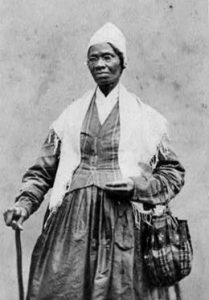
The Right Honourable Deaconess, Sojourner Truth
Sojourner Truth was born Isabella (Belle) Baumfree in 1797 and ascended in peace on November 26th, 1883. Truth was born into slavery in Swartekill, Ulster County, New York, but escaped with her infant daughter to freedom in 1826.
She later said;
“I did not run off, for I thought that wicked, but I walked off, believing that to be all right”.
After going to court to recover her son Peter, in 1828 she became the first black woman to win such a case against a white man. Truth had a life-changing religious experience whilst living with the Van Wagenens, Christians who had helped her win back her son Peter. She then became a devout Christian. In 1829 she moved with her son Peter to New York City and in 1843 Sojourner became a Methodist, subsequently on June 1st, changing her name to Sojourner Truth. She told friends:“The Spirit calls me, and I must go” and left to make her way travelling and preaching about the abolition of slavery.
After she gave herself the name Sojourner Truth, she became convinced that God had called her to leave the city and go into the countryside “testifying the hope that was in her”. Her best-known speech was delivered extemporaneously, in 1851, at the Ohio Women’s Rights Convention in Akron, Ohio. The speech became widely known during the Civil War by the title “Ain’t I a Woman?,”. For us this speech offers and represents another example of how, the Bible, Gospel and Christ, when perceived and internalised, by oppressed people, namely P.R.O.A.D. compels them to stand up, not only for their own rights, but for those of their fellow sufferers.
Below is a small extract, from this speech, presented in its original context and language that enables us to see just how, this remarkable Mother of Truth, interpreted Christianity not only for the benefit of African people, but all women generally.
She asked;
I have borne thirteen chilern,
and seen ’em mos’ all sold off to slavery,
and when I cried out with my mother’s grief,
none but Jesus heard me!
And a’n’t I a woman?
“Den dat little man in black dar,
he say women can’t have as much rights as men,
’cause Christ wan’t a woman!
Whar did your Christ come from?
From God and a woman! Man had nothin’ to do wid Him.”
The Credentials and Significance:
She found in the Gospel the guidance, inspiration and strength to liberate herself and her children from slavery, then devoted her life to speaking and raise people’s awareness about the Truth, which at that time; was the ungodly, unchristian-like true horrors of chattel slavery, authorised, condoned and even legitimised by so called Christians. Her Truth and the Truth cannot then or now, be the same truth that was propagated to keep African’s in bondage and slavery. Therefore another clear example of a African-Centred interpretation of the Holy Gospel.
15. Gebre Mesqel Lalibela
A Guardian of the Temple Structure
HIM Emperor Lalibela, Defender of the Ethiopian Faith
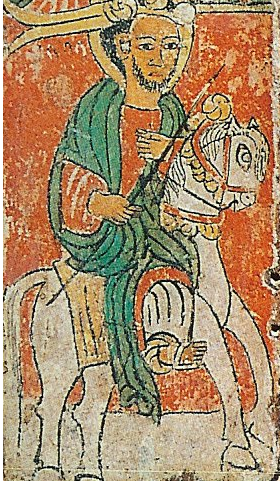 Lalibela’s regnal name was, Gebre Meskel (Ge’ez: ገብረ መስቀል, lit. ‘Servant of the Cross’;). He was born in the year 1162, ascended to the Throne of Ethiopia 1181, until he ascended to His Maker in the year 1221.
Lalibela’s regnal name was, Gebre Meskel (Ge’ez: ገብረ መስቀል, lit. ‘Servant of the Cross’;). He was born in the year 1162, ascended to the Throne of Ethiopia 1181, until he ascended to His Maker in the year 1221.
Emperor Lalibela was from the Zagwe dynasty, and according to Taddesse Tamrat, he was the son of Jan Seyum and brother of Kedus Harbe. He is the most well-known of the Zagwe monarchs, due to the monolithic churches of Lalibela named after him, which are attributed to his reign. He is venerated as a saint by the Orthodox Coptic Ethiopian Tewahedo churches.
Early during the reign of Lalibela, he saw Jerusalem in a vision and believed this vision to be a command from God for him to build a new Jerusalem, as his own capital in Ethiopia, in response to the capture of old Jerusalem by Muslims in 1187.
As such, his new capital was home to 11 rock-cut monolithic churches and featured towns with Biblical names including a river, known as the River Jordan (Amharic: ዮርዳኖስ ወንዝ, translit. Yordanos Wenz). The city remained the capital of Ethiopia from the late 12th century and into the 13th century.
Details about the construction of his 11 monolithic churches at Lalibela have been lost.
However the later Gadla Lalibela, a hagiography of the king, states that he;
carved these churches out of stone with only the help of angels.
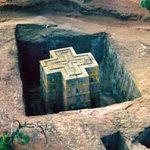 Although little written material concerning the construction of these Churches exist, a sizeable quantity information concerning Lalibela’s reign remains, much of this is contained within the Gadla Lalibela, plus other sources.
Although little written material concerning the construction of these Churches exist, a sizeable quantity information concerning Lalibela’s reign remains, much of this is contained within the Gadla Lalibela, plus other sources.
There was also an embassy from the Patriarch of Alexandria that visited Lalibela’s court around 1210, and they have also left an account of him.
From this information, we learn that Emperor Lalibela, was a very religious, devoted and righteous monarch, a good example of the historic character of many Ethiopian monarchs in history.
The Credentials and Significance:
Emperor Lalibela, his reign and his achievements, namely the 11 Churches; are of the utmost importance and significance, not only for African people, but for all Christians and humanity in general, as not only has he left us these remarkable rock cut churches, still today, baffling architects and scientist to their construction, but these Churches, also offers us an insight and glimpse, into the one of the last examples on earth, of the lost arts of masonry. Notwithstanding that his capital and these churches are claimed to represent the site of the New Jerusalem, when it comes down from heaven.
16. Enoch Mgijima
Guardian of A Temple Gate
The Right Honourable Prophet, Enoch Mgijima
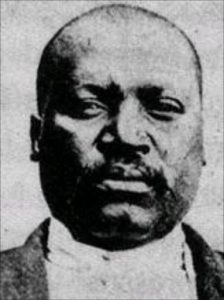
Enoch Mgijima was born in the year 1868 and ascended on 5th March 1928, in peace. He is remembered as an African Christian Xhosa prophet and evangelist. Enoch Mgijima, was born in Bulhoek, 25 km southwest of Queenstown to parents Jonas Mayekiso Mgijima and MaKheswa. He completed Standard 3 (Grade 5) at a local school but could not go to Lovedale because of severe headaches. He later became a Wesleyan lay preacher, hunter and farmer. In April 1907, Mgijima had his first vision in which an angel said to him:
“I have sent you to these people because I am worried that although they worship me, they are not honest in their worship of me. I want you to worship me according to your old traditions.”
After ignoring the vision, Mgijima began preaching again and acquired a large following as an evangelist. In 1910, after seeing Halley’s Comet, Mgijima believed his vision had been confirmed, a sign that God was angry with humans and that they should return to their Old Testament beliefs.
In 1912, Mgijima broke away from the Wesleyan Methodist Church and began baptising his followers whom he called the “Israelites” in the Black Kei River. Mgijima, who had accumulated a large following, stood up at the tabernacle during a church service in 1919 and said; “Juda, Efrayime, Josef, nezalwane (Judah, Ephraim, Joseph and brethren)”.
According to his followers, Israelites all over the country heard these words and understood that they were to come to Ntabelanga, their prophet’s holy village, and await the Lord’s coming. By 1921, 3000 Israelites had arrived in Ntabelanga. After continuous disagreements over land and the prolonged stay of Israelites in Bulhoek, the white South African government and Mgijima’s followers clashed on 24 May 1921. This resulted in 163 Israelites declared dead, 129 wounded and 95 taken prisoner. The massacre is known as the Bulhoek massacre. Mgijima, survived this massacre and with his elder brother Charles, and Gilbert Matshoba, were tried and sentenced to five years hard labour at DeBeer’s Convict Station in Kimberley.
He was released from prison in 1924 and returned to Bulhoek, where he died 3 years later, on 5 March 1928 at the age of 60
The Credentials and Significance:
He like so many African’s before him and since, after hearing the Gospel and the salvation message of the entire Holy Scriptures, saw within it, the means by which African people could liberate themselves from foreign domination, once they begin to see it and interpret it, through their own unique Ethiopian Spectacles and therefore Spirituality. Once a criminal act, today crucial and critical, for African people to both reclaim and save themselves.
17. King Azana
A Temple Guardian of the Entrance
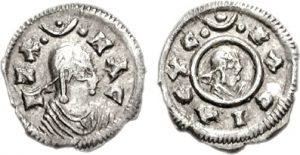
King Ezana Defender of the Faith
Ezana of Axum (Ge’ez: ዔዛና ‘Ezana, unvocalized ዐዘነ ‘zn; also spelled Aezana or Aizan) was ruler of the Kingdom of Aksum (320s – c. 360 CE).
The Kingdom of Axum covered and large area and would be located in present-day northern Ethiopia, Yemen, part of southern Saudi Arabia, northern Somalia, Djibouti, Eritrea, and parts of Sudan. King Ezana himself had the official title “king of Saba and Salhen, Himyar and Dhu-Raydan”. A number of coins minted bearing King Ezana’s name, were found in the late 1990s at archeological sites in India, indicating Axum’s trade contacts in that country.
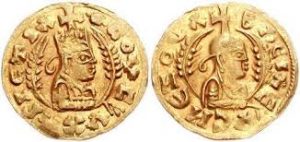 King Ezana is remembered in history to have been the first monarch of the Kingdom of Aksum to embrace Christianity as the state religion. His childhood tutor, the Syrian Christian Frumentius, who had being shipwrecked and captured at an early age, Frumentius was carried to Aksum, where he was treated well with his companion Edesius. At the time, there was a small population of Christians living there who sought refuge from Roman persecution.
King Ezana is remembered in history to have been the first monarch of the Kingdom of Aksum to embrace Christianity as the state religion. His childhood tutor, the Syrian Christian Frumentius, who had being shipwrecked and captured at an early age, Frumentius was carried to Aksum, where he was treated well with his companion Edesius. At the time, there was a small population of Christians living there who sought refuge from Roman persecution.
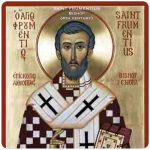 Although Christianity had existed long before Frumentius had come to Ethiopia and the rule of King Ezana the Great of the Kingdom of Axum, however it was through the inspiration and partnership of these two individuals that the religion took a strong foothold and was declared the state religion by 330 AD.
Although Christianity had existed long before Frumentius had come to Ethiopia and the rule of King Ezana the Great of the Kingdom of Axum, however it was through the inspiration and partnership of these two individuals that the religion took a strong foothold and was declared the state religion by 330 AD.
This had followed the meeting of Frumentius with Athanasius, Pope of Alexandria and All Africa. After recommending that a bishop be sent to proselytize, a council decided that Frumentius be appointed as a bishop for Ethiopia and Ethiopians became united with the Coptic Egyptian Oriental Orthodox Church, as it remain until this day.
A remarkable feature of the coins of Ezana as show here, is a shift from a pagan motif with disc and crescent to a design with a cross. ‘Ezana is also credited for erecting several stelae and obelisks.
This recorded event in history, of King Ezana, makes Ethiopia, only the second country in the world, to accept and establish Christianity as its state religion, next only to Armenia, who had done so only 30 years prior to this in 301 AD. It should also be noted and understood that this event took place, over 150 years before Rome itself became Christian and at least 700 years before the rest of Europe.
The Credentials and Significance:
Not only did King Ezana make Ethiopia the second Christian state in the world, but as Ethiopia, has also remained for nearly 1700 years, a Christian state, with minor interruption, this also makes Ethiopia, the oldest continuous Christian state on Earth. And since they have never been conquered by outside forces, it is also sure proof, not only that the Bible & Gospel can act as the greatest tools to resistance and for freedom, but proves beyond doubt that The One God of Ethiopia, has and ill never forsake HIS Children.
18. Bayan Malak
A Temple Guardian & Keeper of the Font
The First none-Jewish Ethiopian Christian
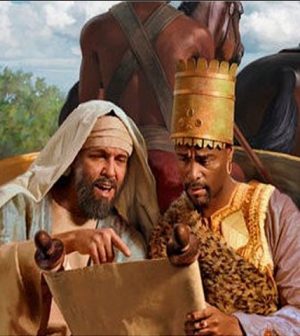 Bayan Malak, is the name of The Ethiopian Eunuch, who is mentioned in the New Testament book of Acts, as the name recorded in the Monarch List, presented by HIM Haile Sellassie Ist in 1922.
Bayan Malak, is the name of The Ethiopian Eunuch, who is mentioned in the New Testament book of Acts, as the name recorded in the Monarch List, presented by HIM Haile Sellassie Ist in 1922.
The Ethiopian eunuch (Bayan Malak) mentioned in the Bible was a high court official of Candace, the queen of Ethiopia.
He was in Israel to worship the Lord at the temple, however on his way back home to Ethiopia, he had an encounter with Philip the evangelist.
This encounter is recorded in the Book of Acts verse 8 and is one of the most important events in the Bible, specifically for African Christians.
The story begins with Philip, one of the seven original deacons, who had just preached the gospel in Samaria (Acts 8:4–8). Philip was visited by an angel who told him to go south to a road that ran from Jerusalem to Gaza, in the desert (Acts 8:26). Philip didn’t ask why he was being sent to the middle of nowhere; he just went (verse 27). On the road, in a chariot, was the Ethiopian eunuch (Bayan Malak), who was just returning from Jerusalem.
The eunuch was sitting in his chariot reading the book of Isaiah. The Spirit of the Lord told Philip to go over and join the chariot, and when Philip drew close he overheard the eunuch reading from the Book of Isaiah out loud. Philip asked Bayan Malak whether or not he understood what he was reading. He replied, “How can I, unless someone guides me?” He then invited Philip to come sit with him in the chariot (verse 31).
The passage the Ethiopian eunuch was reading was this:
“He was led like a sheep to the slaughter,
and as a lamb before its shearer is silent, so he did not open his mouth.
In his humiliation he was deprived of justice.
Who can speak of his descendants? For his life was taken from the earth”
(Acts 8:32–33; cf. Isaiah 53:7–8).
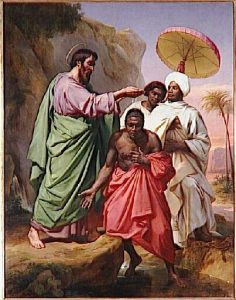 The eunuch was wondering whom the prophet was talking about, “himself or someone else?” (Acts 8:34). Philip used this opportunity to explain the passage: this was a prophecy about Jesus Christ, who meekly gave His life to save the world.
The eunuch was wondering whom the prophet was talking about, “himself or someone else?” (Acts 8:34). Philip used this opportunity to explain the passage: this was a prophecy about Jesus Christ, who meekly gave His life to save the world.
As Philip explained the gospel, the Ethiopian eunuch believed. When they came to some water by the side of the road, the eunuch asked to be baptised (Acts 8:36).
Philip agreed to baptise him, and the Ethiopian eunuch “gave orders to stop the chariot. Then both Philip and the eunuch went down into the water and Philip baptised him” (Acts 8:38).
As soon as the Ethiopian eunuch came up out of the water, “the Spirit of the Lord suddenly took Philip away, and the eunuch did not see him again, but went on his way rejoicing”
The Credentials and Significance:
The Ethiopian Eunuch, Bayan Malak, is of the utmost importance and of the greatest significance to African Christianity and African people generally, for a number of reasons. Such as; He was the first none-Jew on record to be Baptised in the Name of Yahshuah. He was the first Ethiopian to convert to Christianity. Yahovayah sent an Angel directly to instruct Philip to go to him. He already knew and practised the Jewish faith and was reading the Book of Isaiah, to name but a few. Each of these significances, having a particular relevance to African people’s True devotion and unique relationship with Yahovayah & Yahshuah,
19. George Lisle
A Temple Guardian Holder of A Lamp
The Right Honourable, Deacon George Lisle
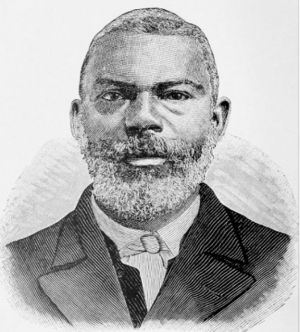 George Lisle, Liele, or Leile, or George Sharp was born in 1750 and ascended sometime during the year of 1820. He was an African American and emancipated slave who became the founding pastor of First Bryan Baptist Church and First African Baptist Church, in Savannah, Georgia (USA).
George Lisle, Liele, or Leile, or George Sharp was born in 1750 and ascended sometime during the year of 1820. He was an African American and emancipated slave who became the founding pastor of First Bryan Baptist Church and First African Baptist Church, in Savannah, Georgia (USA).
Liele was born into slavery in Virginia, but by 1752, was taken to Georgia. As an adult he was converted to Baptist Christianity by Rev. Matthew Moore of Burke County, Georgia, in 1777.
Liele was freed by his master Henry Sharp, also a Baptist and Loyalist, before the American Revolution began. Sharp died in battle as a Tory major on March 1, 1779. Liele went to Savannah, Georgia and helped organize an early Baptist congregation.
After the Revolution had ended, Liele chose to leave with the British to ensure his freedom rather than risk reenslavement in the American South. He migrated to Jamaica with his wife Hannah and their four children and became the first American missionary, leaving in 1782 for Jamaica and also became the first Baptist missionary in Jamaica. He preached at the racecourse at Kingston, Jamaica and attracted considerable attention. Liele was soon able to gather a congregation and purchase a piece of land about a mile from Kingston, where he gradually built a chapel.
To support his work, and expand it, Liele sought support from London. He was helped in this endeavour by Moses Baker, who arrived in Jamaica from the United States in 1783. He converted to Christianity and was baptised by Liele.
Both of these men were attached and affiliated directly to the Ethiopianism movement that was beginning to sweep Africa & the Black America at that time. In 1792 Liele penned the church covenant, and by 1794 along with Moses baker, both had simultaneously established Ethiopian Baptists Church’s on the Jamaica.
The Credentials and Significance:
George Lisle, success in Jamaica was based upon his African-centred ministry that was a product of his times, when African’s all over the world, were beginning to see and interpret the Holy Scripture and the Gospel in particular through Ethiopian spectacles, called Ethiopianism. His contribution to the struggle against the oppressive Christian world is also unparalleled, as his Baptist movement initiated in Jamaica, eventually gave us, Moses Baker, Sam Sharpe and Paul Bogel, three other Temple Guards and 3 national Hero’s of Jamaica, including William Gordon.
20. St Moses the Black
A Temple Guardian
The Right Honourable Monk, Moses the Black
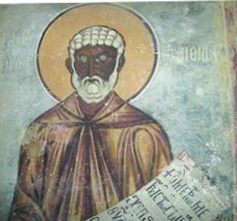 Moses the Black was born in the year 330 and ascended in the year 405, after being martyred by bandits. He is also known as Abba Moses the Robber, and the Strong. Moses the Black, not to be confused with Moses the Prophet, was an ascetic monk and priest in Egypt during the fourth century AD, he is one of many notable Coptic Egyptian Desert Father.
Moses the Black was born in the year 330 and ascended in the year 405, after being martyred by bandits. He is also known as Abba Moses the Robber, and the Strong. Moses the Black, not to be confused with Moses the Prophet, was an ascetic monk and priest in Egypt during the fourth century AD, he is one of many notable Coptic Egyptian Desert Father.
Moses the Black was a servant of a government official in Egypt, who dismissed him for theft and suspected murder. Due to Moses being large in structure, strong and fearless, he became the leader of a gang of bandits who roamed the Nile Valley spreading terror and violence.
On one particular occasion, after having one of his planned burglaries foiled, in an attempt to get revenge, he was again hindered, so fled, stealing some sheep and took shelter with some monks in a colony in the desert of Wadi El Natrun, then called Scetes, near Alexandria, in an attempt to hide from the authorities, who were on his trail. Whilst hiding out in the desert, amongst these Christian monks, Moses became enthralled by the dedication of their lives, as well as their peace and contentment that deeply influenced and impressed him. He soon decided to give up his old way of life, became a Christian, was baptized and joined the Coptic monastic community at Scetes.
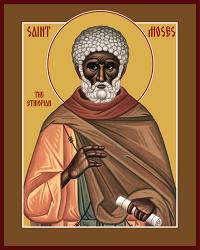 Moses was zealous in all that he did and soon proved to be effective as a prophetic spiritual leader, leading a colony of hermits in the Western Desert and was later ordained a priest.
Moses was zealous in all that he did and soon proved to be effective as a prophetic spiritual leader, leading a colony of hermits in the Western Desert and was later ordained a priest.
There are many amazing stories about Moses’ devotion, his humility and his love for Yahshuah, Yah and humanity in general.
One of these stories has particular significance and relevance for us today, in our modern age and is sighted here in summary, to give us some insight into his remarkable character and Christian virtues, as well as his importance in the 21st century, for African people in the Diaspora.
“Once when his cell was attacked by a group of robbers in his desert, Moses fought back, overpowered the intruders, and dragged them to the chapel where the other monks were at prayer. He told the brothers that he did not think it is Christian to hurt the robbers and asked what he should do with them. The robbers themselves repented and joined the community as brothers afterwards”.
The Credentials and Significance:
Moses’s life of crime before his conversion to Coptic Christianity, together with his life and his many notable achievements and contribution to the hermit tradition of Egypt, after his conversion, is well documented, revered and honoured within the Oriental Christian tradition, 1600 years after his ascent. This Great Saint Moses the Black, offers us and those people who have unfortunately found themselves on the wrong side of righteousness, a model, the inspiration and the confidence to know that regardless of past defects, forgiveness and righteousness is always open & available to the faithful seeker.
21. St Maurice
Guardian of A Temple Gate
The Right Honourable Deacon. St Maurice
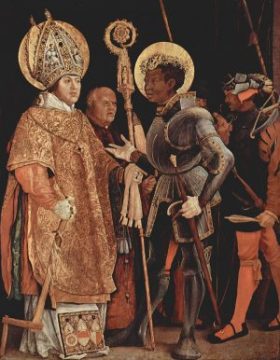 Maurice (also Moritz, Morris, or Mauritius) who name also means black, was an Nubian Egyptian, born around the year 250 AD in Thebes, Upper Egypt (capital of the Egyptian New Kingdom, 1575-1069 BC), he was brought up in the region of Luxor. Very little is known about his childhood and early life. What we do know about his life starts when Maurice became a soldier in the Roman army.
Maurice (also Moritz, Morris, or Mauritius) who name also means black, was an Nubian Egyptian, born around the year 250 AD in Thebes, Upper Egypt (capital of the Egyptian New Kingdom, 1575-1069 BC), he was brought up in the region of Luxor. Very little is known about his childhood and early life. What we do know about his life starts when Maurice became a soldier in the Roman army.
He was a committed and skilled soldier and therefore was gradually promoted until he became the commander of the entire Theban legion, comprising approximately a thousand men, supposedly all Christians. His story begins when he and his Legion were called from Thebes, to Gaul (Western Europe) to assist Emperor Maximian to put down a revolt.
However before going into battle, they were ordered to offer sacrifices to the pagan Roman gods and also pay homage to the emperor. Maurice pledged his Legion’s allegiance to Rome, however refused to sacrifice to their gods and stated that for his Legion, service to God superseded all else.
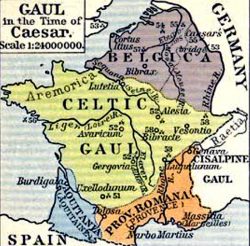 Maximian, although outraged, as he badly needed their assistance, allowed this disobedience on this occasion. However he then ordered the Legion to harass some local Christians, but they refused. This was the last straw, so he ordered the punishment of the Legion, for its insubordination, having every tenth soldier killed, also known as decimation. More orders followed, the Legion refused as encouraged by their leader Maurice, and a second decimation was ordered. In response to the Theban Christians’ refusal to attack any fellow Christians, Maximian ordered all the remaining members of his legion to be executed. This event occurred in what is now Switzerland, known as Agaunum, presumably on the site of the present Abbey of St. Maurice.
Maximian, although outraged, as he badly needed their assistance, allowed this disobedience on this occasion. However he then ordered the Legion to harass some local Christians, but they refused. This was the last straw, so he ordered the punishment of the Legion, for its insubordination, having every tenth soldier killed, also known as decimation. More orders followed, the Legion refused as encouraged by their leader Maurice, and a second decimation was ordered. In response to the Theban Christians’ refusal to attack any fellow Christians, Maximian ordered all the remaining members of his legion to be executed. This event occurred in what is now Switzerland, known as Agaunum, presumably on the site of the present Abbey of St. Maurice.
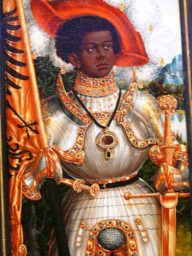 Saint Maurice became a patron saint of the German Holy Roman Emperors from the 10th century, his sword and spurs were part of the regalia used at coronations of the Austro-Hungarian emperors until 1916. Maurice is also the patron saint of the many European cities and town, found in Switzerland, Germany, France, Hungry, Denmark and other Western European countries.
Saint Maurice became a patron saint of the German Holy Roman Emperors from the 10th century, his sword and spurs were part of the regalia used at coronations of the Austro-Hungarian emperors until 1916. Maurice is also the patron saint of the many European cities and town, found in Switzerland, Germany, France, Hungry, Denmark and other Western European countries.
Several orders of chivalry were established in his honor as well, including the Order of the Golden Fleece, Order of Saints Maurice and Lazarus, and the Order of Saint Maurice. Over 650 religious foundations dedicated to Saint Maurice can still be found in France and other European countries. Additionally, fifty-two towns and villages in France have been named in his honor.
The Credentials and Significance:
St Maurice although a black African, is one of the few Black people, of great influence within the Christian tradition, who has retained his identity into the Modern age, within western European art. Not only is this very important, but significantly, even though being Black skinned, he has still been revered throughout the middle ages up to the present. St Maurice nevertheless has great value for African Karastians (Christian’s) in this age, first to be reclaimed into our heritage and secondly, as a role model, for refusing to follow foreign idols, disguised as African, Hebrew, Israelite deities.
22. Walatta Petros
A Temple Guardian & Holder of A Lamp
The Right Honourable Abbess, Walatta Petros
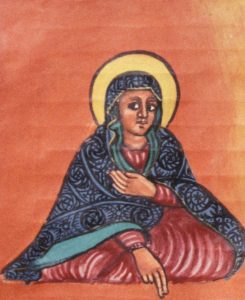 Walatta Petros (Ge’ez: ወለተ፡ጴጥሮስ, Wälättä P̣eṭros), was born in the year 1592 and ascended in peace in year 1642 AD. Walatta Petros was born into a noble family with hereditary rights to lands in southern Abyssinia. Her father and brothers were also officials at court.
Walatta Petros (Ge’ez: ወለተ፡ጴጥሮስ, Wälättä P̣eṭros), was born in the year 1592 and ascended in peace in year 1642 AD. Walatta Petros was born into a noble family with hereditary rights to lands in southern Abyssinia. Her father and brothers were also officials at court.
Walatta Petros was married at a young age to a man named Mälka’ä Krastos, one of King Susenyos’s counselors. She gave birth to three children, but unfortunately all had died in infancy.
After Jesuit missionaries had privately converted King Susenyos from the traditional Ethiopian orthodoxy to Roman Catholicism in 1612, he called on Walatta Petros’s husband to repress the anti-Catholic rebellion started in 1617.
When Mälka’ä Krastos left to fight the rebellion, leading bishops in the Ethiopian monasteries on Lake Tana assisted Walatta Petros in leaving her husband and joining them. After arriving at a monastery on Lake Tana, she took a vow of celibacy and shaved her head to become a nun age of 25 in 1617, in the Ethiopian Orthodox Täwahedo Church, refusing to convert to Roman Catholicism.
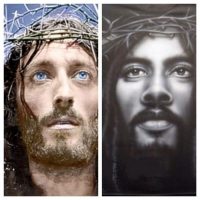 In 1621, King Susenyos forbid the teaching of Ethiopian orthodoxy and Walatta Petros began to protest the king’s abandonment of Ethiopia’s faith to embrace foreign beliefs and rituals. For this she was called before the court in 1622 and again in 1625, for preaching also that people should reject the faith of the foreigners and never mention the name of the king during the liturgy. On both occasions she was spared by the King, due to the appeals and influence of her family & her husband, although seperated. Her husband urged the King not to kill her, but to send the leader of the Jesuit priests, Afonso Mendes, to try to convert her. When Mendes was unsuccessful, the king sent her into exile in Sudan for three years.
In 1621, King Susenyos forbid the teaching of Ethiopian orthodoxy and Walatta Petros began to protest the king’s abandonment of Ethiopia’s faith to embrace foreign beliefs and rituals. For this she was called before the court in 1622 and again in 1625, for preaching also that people should reject the faith of the foreigners and never mention the name of the king during the liturgy. On both occasions she was spared by the King, due to the appeals and influence of her family & her husband, although seperated. Her husband urged the King not to kill her, but to send the leader of the Jesuit priests, Afonso Mendes, to try to convert her. When Mendes was unsuccessful, the king sent her into exile in Sudan for three years.
In the Sudan she continued her preaching, setting up and leading the religious communities that formed around her, seeking to escape Roman Catholicism.
Over her lifetime, she set up seven separate religious communities, the first in the Sudan, called Žäbäy (ca. 1627), and six around Lake Tana: Č̣anqʷa (ca. 1630), Maselle (ca. 1630), Zäge (ca. 1632), Dämboza (ca. 1637), Afär Färäs (ca. 1638), and Zäbol/Zämbol (ca. 1641).
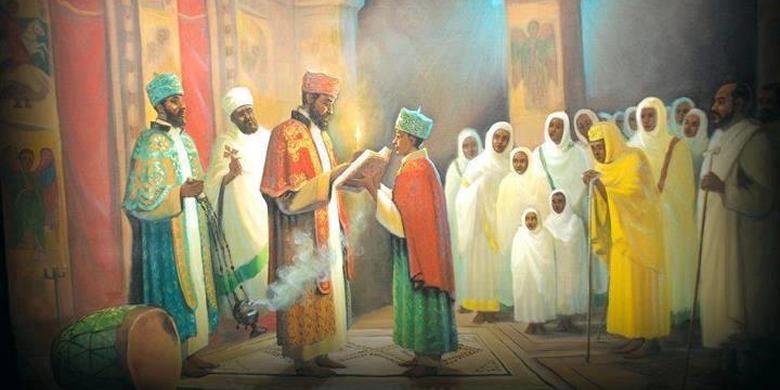
However by 1632, King Susenyos gave up trying to convert the nation to Roman Catholicism and abdicated in favor of his son Fasilädäs who soon became king. Fasilädäs quickly eradicated Roman Catholicism from the country, restoring the Traditional Ethiopian Täwahedo Church.
Walatta Petros continued as the abbess of her mobile religious community, leading it with her woman friend and without any male leadership. After a three-month illness, Walatta Petros ascended in peace on November 23rd, 1642 CE
The Credentials and Significance:
The Life-Struggles, Resistance and accomplishments of Walatta Petros, is of much significance today on a number of levels. Not only should she be revered for resisting conversion to Roman Catholicism, but also for public speaking out against it. She is also important as she formed many religious communities, without the aid or leadership of men. Her story also highlights, the era, when Rome was trying to extinguish the Ethiopian Christian faith, as well as illustrates clearly how; although both professing the same Christ and presumably Faith, from a Ethiopian perspective the Romans have totally, foreign beliefs and rituals.
23. John Chilembwe
Guardian of A Temple Gate
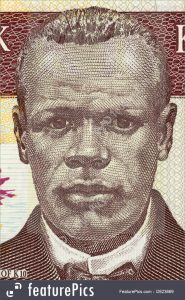 The Right Honourable Reverend, John Chilembwe.
The Right Honourable Reverend, John Chilembwe.
Reverend John Chilembwe was born in the year 1871 and ascended on February 3, 1915 after being executed and martyred by the Colonial British government.
Nothing is really known about his life until in 1892 when he became a house servant of Joseph Booth, a white, radical and independent-minded missionary from Derby, England. In Booth’s household and mission Chilembwe became acquainted with Booth’s radical religious ideas. Booth is often created with using and possibly coining the phrase ‘Africa for the African’s, latter popularised by the Garvey, through his UNIA.
Booth left Nyasaland with Chilembwe in 1897, to visit the United States. Booth however returned to Nyasaland alone in 1899, but Chiembwe remained in the U.S, where he was ordained as a Baptist minister at Lynchburg in 1899 and then he returned to Nyasaland 1900, in his own words, “to labour amongst his benighted race”.
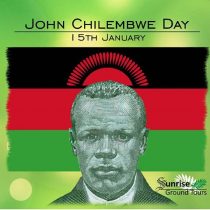 He preached the values of hard-work, self-respect and self-help to his congregation. By 1912, Chilembwe had founded several schools, which had 1,000 pupils and 800 adult students. However, by 1912 or 1913, Chilembwe had also become more politically militant and openly voiced criticism over the state of African land rights and of the conditions of labour tenants that moved him towards thoughts of revolt.
He preached the values of hard-work, self-respect and self-help to his congregation. By 1912, Chilembwe had founded several schools, which had 1,000 pupils and 800 adult students. However, by 1912 or 1913, Chilembwe had also become more politically militant and openly voiced criticism over the state of African land rights and of the conditions of labour tenants that moved him towards thoughts of revolt.
In December 1914 and early January 1915, Chilembwe and his leading followers aimed at attacking British rule and supplanting it, if possible. He began his uprising in late January and it lasted only a few days and was hugely unsuccessful, due to lack of local support. After avoiding attempts to capture him and apparently trying to escape into Mozambique, he was tracked down and killed on February 3.
The aims of the rising remain unclear, partly because Chilembwe and many of his leading supporters were killed, and also because many documents were destroyed in a fire in 1919. However, use of the theme of “Africa for the Africans” suggests a political motive rather than a purely millennial religious one.
The Credentials and Significance:
John Chilembwe’s story is again very important for us, as it gives us another insight, into not only how the Bible, Christianity and Christ, has been interpreted to mean something other than submission to your master, has it is commonly perceived when, taught by the master. But it also allows us to look and analyse a very significant era of Black history and a theology seldom highlighted, namely Ethiopianism and its influence upon the Mind-Set of African people, Christians in particular, both in the 18th & 19th century that culminated in its reaching its heights, in the early 20th century through direct works and accomplishment of Marcus Garvey.
24. Absolom Jones
A Temple Guardian
The Right Honourable Mini-Star, Absalom Jones.
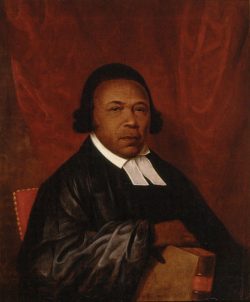 Absalom Jones was born into slavery in Sussex County, Delaware, U.S, on November 7, 1746 and ascended in peace on February 13, 1818.
Absalom Jones was born into slavery in Sussex County, Delaware, U.S, on November 7, 1746 and ascended in peace on February 13, 1818.
When he was sixteen, his owner sold him along with his mother and siblings to a neighbouring farmer, the same year the farmer kept Absalom, but sold his mother and siblings, and moved to Philadelphia, Pennsylvania. Absalom was allowed to attend a school here and learned to read and write. While still enslaved by Mr. Wynkoop, Absalom married Mary King (an enslaved woman owned by S. King, a neighbor to the Wynkoops), in 1770.
By 1778 Absalom had purchased his wife’s freedom so that their children would be free; Absalom also wrote to his master seeking his own freedom, but was initially denied, but in 1784, however, Wynkoop set him free and he took the surname “Jones”.
By 1790 Jones had became a lay minister of the interracial congregation of St. George’s Methodist Episcopal Church in Philadelphia. Together with Richard Allen, Jones was one of the first African Americans licensed to preach by the Methodist Episcopal Church.
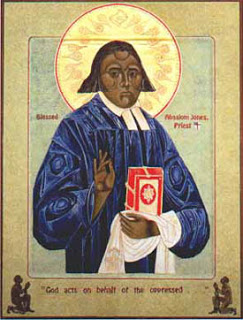 But the white members of the church still practiced racial discrimination, so in 1792, while at St. George’s Methodist Episcopal Church, Absalom Jones and other black members were told not to join the rest of the congregation and instead had to be segregated. After completing their prayer, Jones and most of the church’s black members got up and walked out.
But the white members of the church still practiced racial discrimination, so in 1792, while at St. George’s Methodist Episcopal Church, Absalom Jones and other black members were told not to join the rest of the congregation and instead had to be segregated. After completing their prayer, Jones and most of the church’s black members got up and walked out.
Jones and Allen founded the Free African Society (FAS), a non-denominational mutual aid society, to help newly freed slaves in Philadelphia. Jones and Allen later separated in 1794 as there ministry’s took them in different directs, however they remained lifelong friends and collaborators.
Jones wanted to establish a black congregation independent of white control, while remaining part of the Episcopal Church. After a successful petition, the African Episcopal Church of St. Thomas, the first black church in Philadelphia, opened its doors on July 17, 1794. Jones was ordained as a deacon in 1795 and as a priest in 1804, became the first African-American priest in the Episcopal Church.
A month after St. Thomas church opened, the Founders and Trustees published “The Causes and Motives for Establishing St. Thomas’s African Church of Philadelphia,” saying their intent was
“to arise out of the dust and shake ourselves, and throw off that servile fear,
that the habit of oppression and bondage trained us up in.”
Until ascending in peace on 13th February 1818, Jones continued to work tirelessly, through the ministry of his church, to raise the social and economical condition, he petitioned congressed, spoke openly and slavery and was very vocal about the need for Black people, to own, run and develop their own Church’s independent of outside control.
The Credentials and Significance:
He devoted his life to first obtaining his own freedom, then that of his brethrin, not only physically but also spiritually. He co-founded the Free African Society and help to establish the African Methodist Episcopal Church (AME) in 1794, the first independent black Methodist denomination in the United States. He like his trusted associate Richard Allen and others, saw the need for African’s to worship the Divine and Christ, through their own unique Spectacles, Temples & Churches.
Summary Note:
Although we have selected here these 24 Priests to Guard our Temple, this is but a very small sample of the Priest available to us, which we could have used. There are hundreds even thousands of individuals from the heritage of African people, who have specific relevance to the African Christian Tradition, who could have been selected here as Temple Priests. However these 21 Priest, as Temple Guards to a Living and functioning Temple, although representing the earthly part of the symbolic 24 elders ceaseless praying, although not actually not requiring Rest themselves, as they Have this in abundant Peace, but due specifically for the natural and customary changing of the Guard, we present as the first watch.
Therefore This Temple and it is recommended that each of any Living Temple set up through it, can at any time change any of the Temple Guards, with suitable individuals, fitting a strict criteria and possibly even more relevant to themselves.
